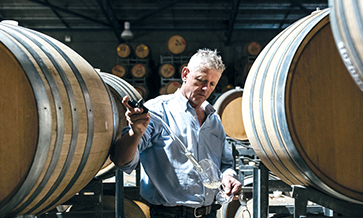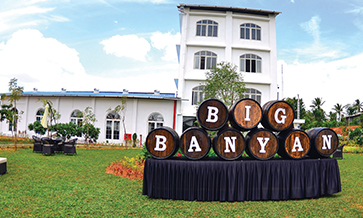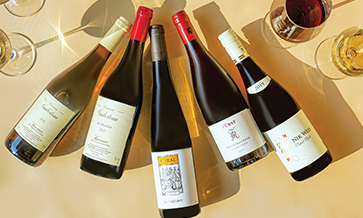On the morning of April 27 this year, we parked our car and walked towards the entrance of Château Pavie in Saint Emilion. A massive statue of a red stone bull with his head down, ready to charge, stood not far away from the doors. A beautiful olive tree and the spectacular vineyards posed as the background.
We were a team of four, eager to begin the holy pilgrimage that Bordeaux offered every year. Come April, the grand châteaux welcomed wine critics, journalists, importers, distributors, and retailers from all over the world to come and taste their wines that have just been put into barrels for ageing.
You might ask: why on earth would they want to offer a taste of unfinished wine? It’s a bit like the futures of the stock market. The critics taste the wine, give you feedback on whether the vintage is good or bad, and then the châteaux release their first prices.
The courtiers – also called middlemen between the châteaux and the merchants – send out allocations. The merchants then start taking orders from their clients. This deal is made even as the wines are evolving in barrels.
After a good 2 years, the wines are put into bottles and then shipped out to the clients who pre-purchase them.
Top class
We were led upstairs into a beautiful salon that had glass panels. It gave a spectacular view of the vineyards. As we were poured the wines, we were told that the vintage was iconic for the Perse family.
I stared at the special engraved bottle. On the top, it read ‘Premier Grand Cru Classé A’ and at the bottom, ‘Ma 25th vendange’ (my 25th harvest). Below that is the name of the proprietor, Gérard Perse. Château Pavie houses one of the finest terroir in Saint-Émilion.
The wine in my glass was bright and vibrant. The nose and the palette were tantalizing, with rich dark ripe, red and black fruits. “This definitely is a powerful wine, just like the bull outside,” I said to myself. No doubt it would surrender beautifully to the palate after at least a decade of ageing!
Our next stop on the list was Château Figeac, which had recently become the talk of the town when it was elevated to ‘Premier Grand Cru Classé A’. It is now among one of the top three châteaux in the classification of Saint Emilion.
My nose and palate feasted. Oozing with charm, this wine, a blend of 35% Merlot, 34% Cabernet Franc and 31% Cabernet Sauvignon had attained a beautiful balance of fruit, tannins and acidity.
Expressive, complex and deep, the nose is seduced by its fresh and rising notes. Subtle floral aromas are supported by delicate touches of spices, indicative of great Cabernet Franc. The character of the Cabernet Sauvignon offers aromas of blackcurrant berries combined with a fresh impression of peppermint.
The quality of the Merlots is soberly expressed by an elegant bouquet of red fruits, including raspberry. Beyond these aromas, notes of minerality, signature of the Figeac gravel. I could easily see why this could be a collector’s dream!
Season of 2022
As I sat in the car, I pulled out a mirror and looked at my teeth. Deep purple and black stains covered every inch of them. It was just the second tasting of that day and already my teeth had borne the brunt!
I quickly took out sparkling water from my bag and rinsed my mouth. I looked into the mirror again. It hadn’t helped much. But I was content: the colour is always a sign of a great vintage.
The growing season in 2022 was very dry. The scorching summer heat and almost no rain had everyone worried. July was the driest ever recorded since 1959. The INAO, a government body that controls the vineyards of Bordeaux, finally permitted three appellations (Pessac-Léognan, Pomerol and Saint-Emilion) to temporarily irrigate their vines.
This had to be done between July 20 and August 15, not before or after. It’s quite rare to see this happen. It rained a little by the end of July giving everyone hope. Then, in August just before the harvest, the skies opened up and it poured, giving the vines everything that was needed to make it a brilliant vintage.
I participated in the harvest that year. The berries were incredibly small, but the concentration of fruit flavours was exceptional.
We made our way to the Union des Grands Cru tasting, which was being held at Cha?teau Beauregard. Lined with wisteria, the whole place was charming. It felt like we were in a dream.
All of the great wines from Pomerol were awaiting us: Cha?teau Le Bon Pasteur, Cha?teau La Cabanne, Cha?teau Clinet, Cha?teau Le Gay, Cha?teau La Croix de Gay, Cha?teau Gazin, Cha?teau La Pointe, Cha?teau Rouget and, of course, Cha?teau Beauregard.
They all showed depth of fruit and excellent concentration on the mid-palate. Cha?teau Clinet, I felt, hit the mark for me!
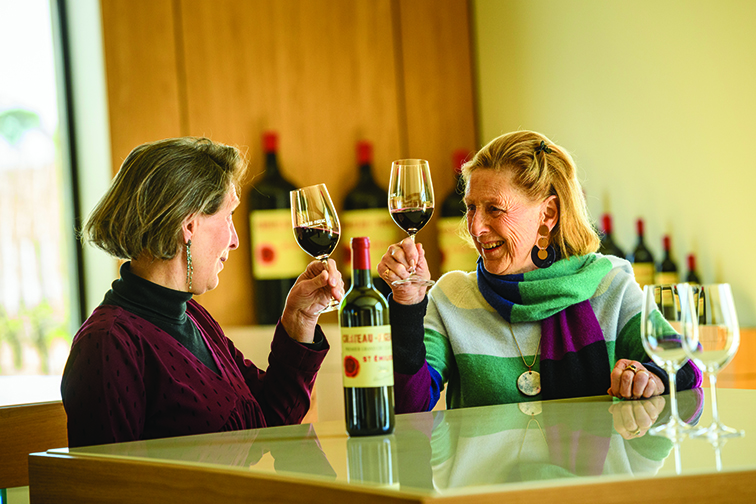
Blandine de Brier Manoncourt and Marie-France Manoncourt (L-R), who co-own Château Figeac with Hortense Idoine Manoncourt (not in picture), toast the recent elevation of their wines to ‘Premier Grand Cru Classé A’.
Cult wines
We stopped at the little village of Saint-Étienne-de-Lisse from where we got a view of the Saint-Etienne’s church bell tower. The surroundings were picturesque. “I shall surely go back to explore more of that region,” I told myself.
Château Tertre Roteboeuf (the hill of the belching steer) is situated in the commune of St.Laurent-des-Combes. The château sits on an elevated land and the vineyards spread out below on a slope. Imagine steers grazing on them and belching!
Everyone knows this wine as a sort of cult wine. There are only 2,000 bottles produced every year! I had tasted the 2021 vintage the previous year and couldn’t wait to see what their 2022 had to offer.
We were joined by Francois Mitjavile and his grandson. The vines are trained incredibly close to the ground to keep the microclimate warm. The vineyards are only six hectares (14.8 acres) in total and all grapes are harvested by hand. They are usually the last to finish harvesting in Saint Emilion.
Francois Mitjavile, along with his daughter Nina and son Louis, make two other wines on different properties: Roc de Cambes in Cote de Bourg and Domaine de l’Aurage in Castillon-Côtes de Bordeaux.
We followed Francois to his underground cellar. It was just like I had seen it the previous year: damp walls were covered in patches of black sooty mould, lovingly called the ‘Angel’s share’.
We were poured wines into our glasses while Francois chatted with us about the vintage. On the nose it was an explosion: chocolate, coffee, vanilla, toast, maraschino cherries and blackberries. I felt that the wine was rich and complex, with layers of flavours perfectly balanced with the tannins.
Their custom-made barrels rendered the wine its distinct coffee notes which has become their signature style over the years. All three wines are synonymous with this.
Unlike many Bordeaux châteaux, they don’t sell through the system of courtiers but sell directly to merchants and importers. However, given the limited quantity, it’s really hard to get any.
Final blend
The gravel crunched beneath our feet as we walked into Château Rauzan-Ségla, a second Grand Cru Classé, in Margaux. Jean-Basile Roland, the commercial director, received us with delight. He had very graciously accepted our last-minute visit request.
We were taken directly to the chai (cellar) where the wines were ageing in barrels. “So which barrel would you like to try?” he asked. I quickly pointed to one that read ‘Demptos’. He carefully lifted the bung (a stopper fitted into the hole of the barrel) and drew some wine with the help of the pipette.
Aromas of black currants, cherries, vanilla, and sweet spices floated as I swirled my glass and took a sniff. The first sip made me taste the intense fruit that persisted on my mid palate. The chewy tannins played tricks on my teeth and gums.
I knew this wine would cast its magic in the final blend. It’s a bit like art: the artist takes different colours and comes up with a masterpiece. Here the colours were the grapes (Cabernet Sauvignon, Merlot and Cabernet Franc) evolving in differently charred barrels sourced from different cooperages.
The final blend awaited us in the tasting room. I thoroughly enjoyed the layers of complexity in this wine. The tannins were so smooth and refined! It had a gorgeous mouth feel and beautiful acidity. They all came together to make the 2022 vintage highly sought after.
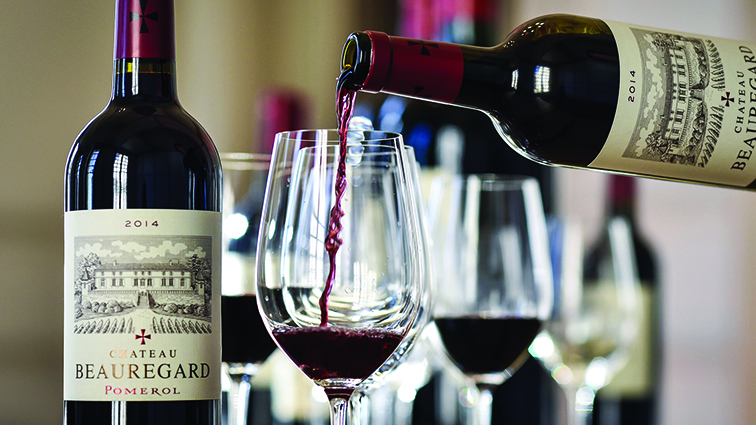
At Cha?teau Beauregard all of the great wines from Pomerol were waiting. They all showed depth of fruit and excellent concentration on the mid-palate.
Remarkable vintage
Our day wouldn’t be complete without tasting Château Phélan Ségur. This magnificent property lies in the heart of the appellation of Saint-Estèphe. The landscape encompassed a large pond, a rolling carpet of green grass and old trees. We were welcomed into the château and poured the 2022 vintage into our glasses.
I noticed the deep colour. On the nose the wine was complex with fruit, floral and spice notes. It has a persistent finish on the palate. Again, here is a rich and powerful wine that maintains a harmonious balance.
Our noses were numb and our palates tired. But I was elated. It was time to rest and return the next day.
It is not every day we come across a year like 2022. The fruit, the concentration, the freshness, it had it all. This was certainly a vintage that could easily qualify as the vintage of the century.
For more information on the wines, and purchasing or allocations, write to me at info@wine-equation, or namratha@wine-equation.com.












